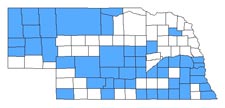Splendid Tiger Beetle |
|
Pictured Below:
Cicindela splendida







Pictured Below:
Apparent intergrades with Cicindela denverensis


|
|
| |
|
|
 |
 |
| Cicindela splendida Hentz |
| Adult Length: 12 to 16 mm |
| Appearance: Adults are green to blue on the dorsal surfaces of the head and pronotum, while the elytra are red with green margins. The maculation pattern is similar to that of C. denverensis and C. limbalis, most often with humeral and posthumeral marks which may be fused into a complete humeral lunule, a middle band that may be complete or reduced to a dash, and an apical lunule which may be complete or broken into distinct apical and subapical dots. Markings may be highly reduced and in some cases only an apical dot and a dot representing the middle band may be all that is present. The color is somewhat variable and the green on the head and pronotum may be replaced by blue, and the red elytra may be coppery or bronze in some cases. Blue and green individuals may also occur. |
| Similar Species: This species could be mistaken for C. scutellaris scutellaris, C. limbalis, or C. denverensis. It differs from C. limbalis and C. denverensis in that the color of the head and pronotum is different from that of the elytra. It differs from C. scutellaris scutellaris in that it is not as shiny, and it normally has a middle band or at least a slash-shaped mark in that location. In C. scutellaris scutellaris the elytra are normally immaculate, and though occasional individuals may have maculation, the middle band marking is never complete or slash-shaped. |
| Biology: This species occurs on steep, bare slopes consisting of clay, loess, very fine sand, or loam. It can often be found in numbers on extensive road cuts. In western Nebraska it co-occurs with C. denverensis, and with C. limbalis in the east. In the central part of the state, all three species may co-occur. There is some evidence of possible hybridization with at least C. denverensis in the vicinity of Kearney. In most other parts of the state there is no such evidence, but it is suspected that if such an intergade zone exists, it should extend to the north and south as well. Adults are often found on nearly vertical slopes, but will often occur on flatter areas nearby, such as gravel roads. |
| Adult Life History: Adults emerge from the pupa in August and September, but many adults apparently remain underground until late winter and spring. Activity resumes in March and April, with peak numbers in April. Numbers drop rapidly in May, and adults are usually rare by the third week of May. As in the other early spring species, numbers decline more slowly in the western part of the state, likely as a result of higher elevation. It is a spring-fall species. |
| Larval Life History: Eggs are laid mostly from late March to May. Most larvae reach the third instar by fall before overwintering. Activity resumes in spring and pupation occurs mostly in July. Larval burrows occur in steep slopes and the opening is perpendicular to the soil surface. The burrow curves toward vertical with depth. There may often be a pit downslope or even a circular cleared area around the opening as may be found in the other two related species as well. Larval burrows are usually no more than 40 cm in depth. |
| Biogeography: This species has been recorded from all over Nebraska and probably occurs in most counties. Apparent intergrades with C. denverensis tend to be coppery, bronze or greenish bronze on the elytra and are found at some localities in the central part of the state. Some individuals from this area may be difficult to identify to species, appearing midway between the two species in characteristics. In North America it occurs from Pennsylvania and South Carolina through the Ohio River Valley region to Wisconsin, Mississippi, Texas, eastern Colorado, and southernmost South Dakota. |
|










